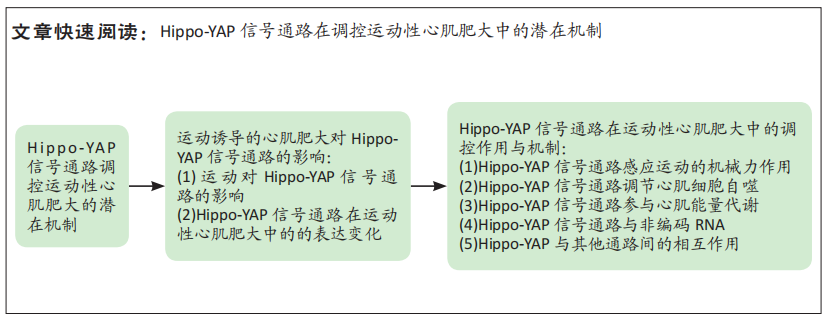中国组织工程研究 ›› 2023, Vol. 27 ›› Issue (17): 2708-2715.doi: 10.12307/2023.443
• 组织构建综述 tissue construction review • 上一篇
Hippo-YAP信号通路在运动性心肌肥大中的调控作用
范清华,齐 洁,张 钧
- 上海师范大学体育学院,上海市 200234
The regulatory role of Hippo-YAP signaling pathway in exercise-induced cardiac hypertrophy
Fan Qinghua, Qi Jie, Zhang Jun
- Institute of Physical Education, Shanghai Normal University, Shanghai 200234, China
摘要:

文题释义:
Hippo-YAP信号通路:是一种高度保守性的信号级联,主要组成包括核心激酶MST1/2、LATS1/2、支架蛋白SAV1、MOB1以及转录辅激活子YAP/TAZ,其生物学信号的输出依赖于YAP/TAZ对下游基因的转录调控。Hippo-YAP信号通路影响细胞生长发育,调控干细胞功能和器官大小,在心血管系统中扮演重要角色。
运动性心肌肥大:是一种由于长期运动训练而引起单个心肌细胞在长度和宽度上生长的现象,具体表现为心脏质量增加、心室壁增厚,同时伴有心室腔扩大和心肌细胞凋亡减少等,是一种生理性结构肥大。运动引起心肌细胞内信号通路的变化而促进生理性心肌肥大,是近年来运动性心肌肥大分子机制相关研究聚焦的热点之一。
背景:Hippo-YAP信号通路是一种在不同物种间高度保守的信号级联,在影响生理性心肌肥大的研究中引发广泛关注。研究发现,众多途径如机械力、自噬、能量代谢参与调控运动性心肌肥大,这些途径可能在运动后与Hippo-YAP信号通路发生相互作用,从而影响运动性心肌肥大的形成和发展。
目的:总结运动对Hippo-YAP信号通路的影响,阐述Hippo-YAP信号通路在调控运动性心肌肥大中的潜在机制。
方法:以“Hippo-YAP信号通路、YAP/TAZ、运动性心肌肥大、心脏、运动”为中文检索词,以“Hippo-YAP signaling pathway,YAP/TAZ,exercise-induced cardiac hypertrophy,physiological hypertrophy,heart,exercise”为英文检索词,检索1983-2022年分别收录在中国知网、PubMed和Web of Science数据库的相关文献,对符合筛选标准的70篇文献进行综述。
结果与结论:Hippo-YAP信号通路受到运动的影响,并且在运动诱导的生理性心肌肥大中具有一定的调控作用。①Hippo-YAP信号通路感应运动触发的机械力刺激,导致YAP/TAZ活性和表达发生改变,介导心肌细胞对机械信号的应答。②Hippo-YAP信号通路调节心肌细胞自噬,维护运动中心肌细胞内环境稳态和正常的结构及生理功能。③Hippo-YAP信号通路可能参与运动性心肌肥大发生过程中能量物质的氧化和糖酵解反应,也可能受到运动期间能量变化的影响。④Hippo-YAP信号通路可能在运动的作用下加强与某些生理性心肌肥大相关ncRNA的联系,多种ncRNA可能共同调节Hippo-YAP信号传导。⑤Hippo-YAP信号通路与胰岛素生长因子1/胰岛素生长因子受体等运动性心肌肥大经典途径发生相互作用,运动促进它们之间的信号传导交互,参与调控运动性心肌肥大。⑥深入研究Hippo-YAP信号通路在运动性心肌肥大中的调控作用,有助于深化对运动促进心脏健康的理解,为临床防治心脏疾病和心肌组织构建提供新的思路和策略。
https://orcid.org/0000-0003-1542-6939(范清华);https://orcid.org/0000-0003-1747-1020(张钧);https://orcid.org/0000-0002-0370-0120(齐洁)
中国组织工程研究杂志出版内容重点:组织构建;骨细胞;软骨细胞;细胞培养;成纤维细胞;血管内皮细胞;骨质疏松;组织工程
中图分类号: